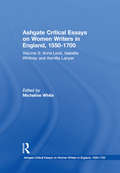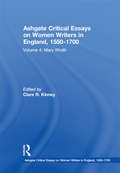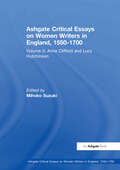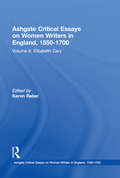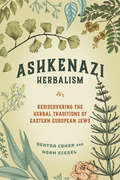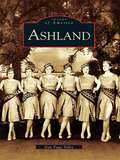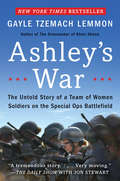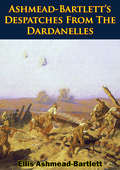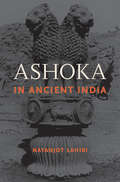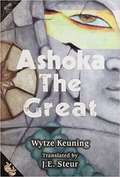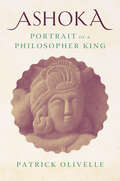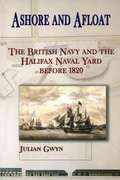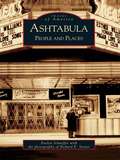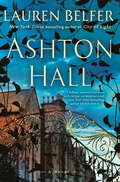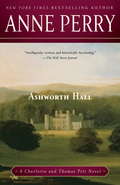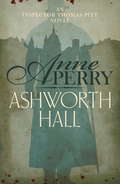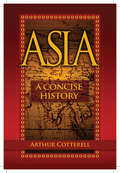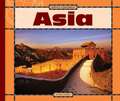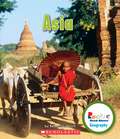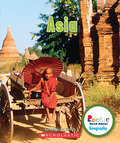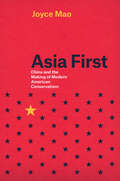- Table View
- List View
Ashgate Critical Essays on Women Writers in England, 1550-1700: Volume 3: Anne Lock, Isabella Whitney and Aemilia Lanyer (Ashgate Critical Essays on Women Writers in England, 1550-1700)
by Clements R. MarkhamAnne Lock, Isabella Whitney and Aemilia Lanyer have emerged as important literary figures in the past ten years and scholars have increasingly realized that their bold and often unorthodox works challenge previously-held conceptions about women's engagement with early modern secular and religious literary culture. This volume collects some of the most influential and innovative essays that elucidate these women's works from a wide range of feminist, literary, aesthetic, economic, racial, sexual and theological perspectives. The volume is prefaced by an extended editorial overview of scholarship in the field.
Ashgate Critical Essays on Women Writers in England, 1550-1700: Volume 4: Mary Wroth (Ashgate Critical Essays on Women Writers in England, 1550-1700)
by Mary Wroth and Clare R. KinneyThe last twenty-five years have seen exciting new developments in scholarly work on Lady Mary Wroth, whose Urania and Pamphilia to Amphilanthus constitute the first romance and the first sonnet sequence to be published by an Englishwoman. Wroth's writings enter into a suggestive and gendered dialogue with the lyric and narrative works of her uncle, Sir Philip Sidney, even as they carve out a place for her own literary experiments. This volume gathers together some of the most striking recent criticism addressing Wroth's oeuvre; many of its essays also discuss the intellectual and cultural contexts in which she wrote. The collection is prefaced by an extended editorial overview of scholarship in the field.
Ashgate Critical Essays on Women Writers in England, 1550-1700: Volume 5: Anne Clifford and Lucy Hutchinson (Ashgate Critical Essays on Women Writers in England, 1550-1700)
by Mihoko SuzukiUntil recently, Anne Clifford has been known primarily for her Knole Diary, edited by Vita Sackville-West, which recounted her steadfast resistance to the most authoritative figures of her culture, including James I, as she insisted on her right to inherit her father's title and lands. Lucy Hutchinson was known primarily as the biographer of her husband, a Puritan leader during the English Civil Wars. The essays collected here examine not only these texts but, in Clifford's case, her architectural restorations and both the Great Book which she had compiled and the Great Picture which she commissioned, in order to explore the identity she fashioned for herself as a property owner, matriarchal head of her family, patron and historian. In Hutchinson's case, recent scholars have turned their attention to her poetry, her translation of Lucretius and her biblical epic, Order and Disorder, to analyze her contributions to early modern scientific and political writing and to place her work in relation to Milton's Paradise Lost.
Ashgate Critical Essays on Women Writers in England, 1550-1700: Volume 6: Elizabeth Cary (Ashgate Critical Essays on Women Writers in England, 1550-1700)
by Karen RaberElizabeth Cary's Tragedy of Mariam, the first original drama written in English by a woman, has been a touchstone for feminist scholarship in the period for several decades and is now one of the most anthologized works by a Renaissance woman writer. Her History of ... Edward II has provided fertile ground for questions about authorship and historical form. The essays included in this volume highlight the many evolving debates about Cary's works, from their complicated generic characteristics, to the social and political contexts they reflect, to the ways in which Cary's writing enters into dialogue with texts by male writers of her time. In its critical introduction, the volume offers a thorough analysis of where Cary criticism has been and where it might venture in the future.
Ashkenazi Herbalism: Rediscovering the Herbal Traditions of Eastern European Jews
by Deatra Cohen Adam SiegelThe definitive guide to medicinal plant knowledge of Ashkenazi herbal healers, from the Middle Ages to the 20th century.Until now, the herbal traditions of the Ashkenazi people have remained unexplored and shrouded in mystery. Ashkenazi Herbalism rediscovers the forgotten legacy of the Jewish medicinal plant healers who thrived in eastern Europe's Pale of Settlement, from their beginnings in the Middle Ages through the modern era.Including the first materia medica of 25 plants and herbs essential to Ashkenazi folk medicine, this essential guide sheds light on the preparations, medicinal profiles, and applications of a rich but previously unknown herbal tradition--one hidden by language barriers, obscured by cultural misunderstandings, and nearly lost to history. Written for new and established practitioners, it offers illustrations, provides information on comparative medicinal practices, and illuminates the important historical and cultural contexts that gave rise to eastern European Jewish herbalism.Part I introduces a brief history of the Ashkenazim and provides an overview of traditional eastern European medicine. Part II offers descriptions of predominantly Jewish towns in the Pale, their many native plants, and the remedies applied by indigenous healers to treat a range of illnesses. This materia medica names each plant in Yiddish, English, Latin, and other relevant languages. Ashkenazi Herbalism also details a brief history of medicine; the roles of the Ba'alei shem, Feldshers, Opshprekherins, midwives, and brewers; and the seferot.
Ashland
by Dale Paige TalleyIn 1837, the Richmond, Fredericksburg, and Potomac Railroad laid its iron-capped wooden rails from Richmond to Aquia Creek. There, passengers could meet a stagecoach that would transport them to the railroad-owned steamship line and cruise up the Potomac to Washington. In between their outset and destination was a boggy, overgrown area known as the Slashes, which seemed the perfect rest stop for weary travelers during the 1850s. The region was renamed Ashland, after native son Henry Clay's home in Kentucky. By 1867, the Civil War had brought economic collapse and a resultant depression, and as a town that had relied on revenue from gambling, horseracing, and other leisure activities, Ashland faced serious challenges to its very existence. Randolph-Macon College, originally in Mecklenburg County, made a deal with Ashland that would save both the town and the nation's oldest Methodist college by reestablishing its campus along their railroad tracks.
Ashley's War: The Untold Story of a Team of Women Soldiers on the Special Ops Battlefield
by Gayle Tzemach LemmonThe New York Times–bestselling account of an elite team of female soldiers is “compelling. . . . In battle as in life, these women refuse to quit” (Christian Science Monitor).In 2010, the Army created Cultural Support Teams, a secret pilot program to insert women alongside Special Operations soldiers battling in Afghanistan. Their presence had a calming effect on enemy households, but more importantly, the CSTs were able to search adult women for weapons and gather crucial intelligence. They could build relationships—woman to woman—in ways that male soldiers in an Islamic country never could.In Ashley’s War, Gayle Tzemach Lemmon uses on-the-ground reporting and a finely tuned understanding of the complexities of war to tell the story of CST-2, a unit of women hand-picked from the Army to serve in this highly specialized role. The pioneers of CST-2 proved for the first time that women might be physically and mentally tough enough to become Special Ops.The price of professional acceptance was personal loss and social isolation: the only people who really understand the women of CST-2 are each other. At the center of this story is a friendship and the shared perils of up-close combat. At the heart of the team is the tale of a beloved and effective soldier, Ashley White. “An unforgettable story of female soldiers breaking the brass ceiling. . . . This book will inspire you.” —Sheryl Sandberg, #1 International bestselling author of Lean In“A tremendous story. . . . Very moving.” —The Daily Show with Jon Stewart“Ashley’s War shares the remarkable stories of one of the first teams of women serving in the U.S. Army Special Operations Command.” —Senator John McCain
Ashmead-Bartlett’s Despatches From The Dardanelles
by Ellis Ashmead-BartlettPublished during the Great War, this book by Ellis Ashmead-Bartlett (1881-1931), a British war correspondent during the First World War, covers the preparations for the assault on Gallipoli, the naval Battle of the Dardanelles, the landings at ANZAC and Cape Helles and the battles for Krithia, Achi Baba and the heights of ANZAC from March to July 1915.Through his reporting of the Battle of Gallipoli, Ashmead-Bartlett was instrumental in the birth of the Anzac legend, which still dominates military history in Australia and New Zealand. Outspoken in his criticism of the conduct of the campaign, he was instrumental in bringing about the dismissal of the British commander-in-chief, Sir Ian Hamilton--an event that led to the evacuation of British forces from the Gallipoli peninsula.
Ashok Aur Mourya Samaj Ka Patan
by Romila ThaparThe book studies the history during the time of Mauryas. The book based on the Shilalekh of Ashoka describes about the finest period of ancient Indian history. The book gives the readers an entire new angle of looking at Mauryans. This book also describes about the various effect of Buddhism . A must for the students of Research in Indian History.
Ashoka in Ancient India
by Nayanjot LahiriIn the third century BCE Ashoka ruled in South Asia and Afghanistan, and came to be seen as the ideal Buddhist king. Disentangling the threads of Ashoka's life from the knot of legend that surrounds it, Nayanjot Lahiri presents a vivid biography of an emperor whose legacy extends far beyond the bounds of his lifetime and dominion.
Ashoka the Great
by Wytze KeuningAshoka The Great chronicles the life of Emperor Ashoka. The original Dutch version was a trilogy, published separately in three volumes. The trilogy was written between 1937-1947 by a Dutch scholar Wytze Keuning in Groningen in the Netherlands. These three volumes Ashoka: The Wild Prince, Book I, Ashoka: The Wise Ruler, Book II and Ashoka: The World's Great Teacher, Book III are now brought together and presented in this single volume Ashoka The Great. The book is an exhilarating, spiritually edifying and deeply moving story of one of India's greatest emperors. It recreates the life and times of the Mauryas with an authenticity that is remarkable. The book presents a plausible vision of the past balanced by a captivating story. It is said that a great book if it is to endure cannot do without profound ideas. Keuning perfectly fuses facts and thoughts, Mauryan customs and mores, life and reflection on the meaning of life as seen through the vision of Ashoka's gurus and the history of personal influences upon Ashoka that marked his rule and legacy. This and more makes it a rare and distinguished book.
Ashoka: Portrait of a Philosopher King
by Patrick OlivelleAn illuminating biography reconstructing the life and legacy of a unique king in world history and the most famous emperor in South Asian history There are few historical figures more integral to South Asian history than Emperor Ashoka, a third-century BCE king who ruled over a larger area of the Indian subcontinent than anyone else before British colonial rule. Ashoka sought not only to rule his territory but also to give it a unity of purpose and aspiration, to unify the people of his vastly heterogeneous empire not by a cult of personality but by the cult of an idea—&“dharma&”—which served as the linchpin of a new moral order. He aspired to forge a new moral philosophy that would be internalized not only by the people of his empire but also by rulers and subjects of other countries, and would form the foundation for his theory of international relations, in which practicing dharma would bring international conflicts to an end. His fame spread far and wide both in India and in other parts of Asia, and it prompted diverse reimaginations of the king and his significance. In this deeply researched book, Patrick Olivelle draws on Ashoka&’s inscriptions and on the art and architecture he pioneered to craft a detailed picture of Ashoka as a ruler, a Buddhist, a moral philosopher, and an ecumenist who governed a vast multiethnic, multilinguistic, and multireligious empire.
Ashore and Afloat: The British Navy and the Halifax Naval Yard Before 1820
by Julian GwynThis book tells the early history of the Halifax Naval Yard. From the building of the yard and its expansion, to the people involved in the enterprise, to the nuts and bolts of buying the masts and paying the bills.
Ashram Observances in Action
by M. K. GandhiGandhiji's ideas in regard to this New Education did not, of course, suddenly emerge from his brain in 1937, but were the outcome of long years of sustained thought and experience. The present book relates to this earlier formative period when he revolted from the prevailing system of education and sought in various ways to substitute it by educational practices more in harmony with his own conception of the function of education. To understand adequately the Basic Education scheme which he formulated in 1937 it is essential to go back to this earlier period where we can see it in origin and growth. The present book may, therefore, be said to be a necessary companion volume to the one on Basic Education.
Ashtabula: People and Places (Images of America)
by Evelyn Schaeffer Richard E. StonerPost-World War II Ashtabula was a major Great Lakes port with a thriving downtown. Local photographer Richard E. Stoner began taking photographs of the growing city in 1938, and for the next 58 years, his lens captured Ashtabula's businesses, industries, and citizens. His commercial accounts ranged from the harbor's Pinney Dock and Transport Company, to Main Avenue's locally-owned Carlisle-Allen Company department store, to Ashtabula's major war industries. Dick Stoner's earlier photographs capture the Ashtabula that once was, including the week-long Sesquicentennial Celebration of 1953. His later photos record the beginnings of fundamental change in our way of life. Also included in this volume are some pre-1930s photographs by Vinton N. Herron, whose work Stoner purchased when Herron retired. For Ashtabulans, this is a family album. For others, it is a look at a bygone time in Midwest America.
Ashton Hall
by Lauren BelferAn American woman and her son stumble upon the dark history of a rambling English manor house in this &“masterful, riveting, and atmospheric&” (Alka Joshi, author of The Henna Artist) novel from New York Times bestselling author Lauren Belfer. &“With vibrant prose, Lauren Belfer shepherds us through a centuries-old mystery and into a modern-day introspection on motherhood, marriage, and love.&”—Georgia Hunter, New York Times bestselling author of We Were the Lucky Ones When a close relative falls ill, Hannah Larson and her young son, Nicky, join him for the summer at Ashton Hall, a historic manor house outside Cambridge, England. A frustrated academic whose ambitions have been subsumed by the challenges of raising her beloved child, Hannah longs to escape her life in New York City, where her marriage has been upended by a recently discovered and devastating betrayal.Soon after their arrival, ever-curious Nicky finds the skeletal remains of a woman walled into a forgotten part of the manor, and Hannah is pulled into an all-consuming quest for answers, Nicky close by her side. Working from clues in centuries-old ledgers showing what the woman&’s household spent on everything from music to medicine; lists of books checked out of the library; and the troubling personal papers of the long-departed family, Hannah begins to recreate the Ashton Hall of the Elizabethan era in all its color and conflict. As the multilayered secrets of her own life begin to unravel, Hannah comes to realize that Ashton Hall&’s women before her had lives not so different from her own, and she confronts what mothers throughout history have had to do to secure their independence and protect their children.&“Infused with the brooding, gothic atmosphere of Jane Eyre or Rebecca&” (Melanie Benjamin, author of The Children&’s Blizzard) and rich with female passion, strength, and ferocity across the ages, Ashton Hall is a novel that reveals how the most profound hauntings are within ourselves.
Ashton-Under-Lyne in the Great War (Your Towns & Cities in the Great War)
by Glynis CooperA new book on Ashton-under-Lyne during World War I is being published as part of a series on Towns and Cities in the Great War to commemorate the centenary of the beginning of the War. It focuses on the economic and social conditions, problems and hardships of those left at home in England played out against a background of military action on the Western Front, in Turkey, Egypt and Palestine. Ashton was both a garrison town and a mill town. There were three Battalions based locally and over 1500 local men lost their lives. Sir Max Aitken, later Lord Beaverbrook, was Liberal Unionist MP for Ashton. In the summer of 1917 five tons of TNT exploded at an Ashton munitions factory destroying mills and houses, setting gasometers on fire and hurling acid drums into the river. Fifty people died and five hundred were injured. The book chronicles the difficulties, hardships, restrictions and morale of the town year by year as the War dragged on; the constant fear of Zeppelin raids; and the determined spirit of the folk of Ashton that the Kaiser would not beat them.
Ashworth Hall: A Charlotte and Thomas Pitt Novel (Charlotte and Thomas Pitt #17)
by Anne PerryWhen a group of powerful Irish Protestants and Catholics gather at a country house to discuss Irish home rule, contention is to be expected. But when the meeting’s moderator, government bigwig Ainsley Greville, is found murdered in his bath, negotiations seem doomed. Unless Superintendent Thomas Pitt and his wife, Charlotte, can root out the truth, simmering hatreds and passions may again explode in murder.
Ashworth Hall: Politics and murder entwine in Victorian London (Thomas Pitt Mystery #17)
by Anne PerryCan Pitt solve the case before the killer strikes again? The murder of a prominent politician has links to Irish civil unrest in Anne Perry's gripping Victorian mystery, Ashworth Hall. Perfect for fans of C. J. Sansom and Sarah Perry.'Elegant period novel with a contemporary resonance' - Guardian When a group of powerful Irish Protestants and Catholics gather at a country house to discuss Irish home rule, contention is to be expected. But when the meeting's moderator, government bigwig Ainsley Greville, is found murdered in his bath, negotiations seem doomed. Unless Superintendent Thomas Pitt and his wife, Charlotte, can root out the truth, simmering hatreds and passions may again explode in murder. What readers are saying about Anne Perry: 'The atmosphere of turn of the century London is so absorbing and tangible that you can almost feel yourself shrouded in a cold blanket of East End fog and hear the Hansom carriages clatter along the streets''These are a great set of books. Pitt is a really likeable hero''Five stars'
Asia
by Arthur CotterellFrom one of the world's leading historians?a comprehensive narrative of the 3,000 years that have formed Asia's people, culture, and global destiny Tracing its origins in Mesopotamia to its modern role on the global geopolitical stage, historian Arthur Cotterell offers a compelling, lively, and readable account of one of the most culturally diverse, and often misunderstood, parts of the world. Beginning with the emergence of the world's earliest civilization in 3000 BC, Asia: A Concise History provides a fascinating look at the global convulsions?like the rise and fall of Assyria and Persia, the medieval states that flourished after the advent of Islam, and the modern transformations triggered by the lightning conquests of imperial Japan?that have shaped the continent. Covers the great events and figures of Asian history, along with a look at the monumental remains that bear witness to those times: the ziggurats of Iraq, the Taj Mahal, the Great Wall of China, the temple of Angkor Wat Includes fascinating slices of history, including funeral arrangements for Qin Shi Huangdi in 210 BC; an extract from Lord Macartney's journal of his 1793 diplomatic mission to the Qing emperor Qian Long; and Toyotomi Hideyoshi's edict of 1587 banning firearms in Japan Features boxed inserts of special interest?like a Babylonian recipe for lamb stew circa 1500 BC Contains over 100 illustrations, maps, and photos Other books by Cotterell: The Minoan World, The First Emperor of China, The Encyclopedia of Mythology, and Chariot Destined to become a reference staple for history buffs and students of Asian history, Asia: A Concise History offers readers a breathtaking narrative and wealth of detail that make the formative periods, key events, and personalities from this once remote part of the world come alive.
Asia (Earth's Continents)
by Mary LindeenEARTH'S CONTINENTS lets you begin exploring Earth's seven continents. Learn about each continent's land, people, animals, and cultures just by turning the pages! Read all the books in the EARTH'S CONTINENTS series: Africa Antarctica Asia Australia Europe North America South America Picture descriptions and captions are present.
Asia (Rookie Read-About Geography: Continents)
by Rebecca Hirsch Roman CybriwskyAn introduction to Asia, focusing on its geographical features and points of interest. <P><P>Rookie Read-About: Continents series gives the youngest reader (Ages 3-6) an introduction to the components that make each continent distinctive and exceptional. Readers will get to know each continents' geography, history, and wildlife. <P><P>Lexile Measure: 410
Asia (Rookie Read-About Geography: Continents)
by Rebecca HirschAn introduction to Asia, focusing on its geographical features and points of interest.Rookie Read-About: Continents series gives the youngest reader (Ages 3-6) an introduction to the components that make each continent distinctive and exceptional. Readers will get to know each continents' geography, history, and wildlife.
Asia First: China and the Making of Modern American Conservatism
by Joyce MaoAfter Japanese bombs hit Pearl Harbor, the American right stood at a crossroads. Generally isolationist, conservatives needed to forge their own foreign policy agenda if they wanted to remain politically viable. When Mao Zedong established the People’s Republic of China in 1949—with the Cold War just underway—they had a new object of foreign policy, and as Joyce Mao reveals in this fascinating new look at twentieth-century Pacific affairs, that change would provide vital ingredients for American conservatism as we know it today. Mao explores the deep resonance American conservatives felt with the defeat of Chiang Kai-Shek and his exile to Taiwan, which they lamented as the loss of China to communism and the corrosion of traditional values. In response, they fomented aggressive anti-communist positions that urged greater action in the Pacific, a policy known as “Asia First.” While this policy would do nothing to oust the communists from China, it was powerfully effective at home. Asia First provided American conservatives a set of ideals—American sovereignty, selective military intervention, strident anti-communism, and the promotion of a technological defense state—that would bring them into the global era with the positions that are now their hallmark.
Asia Inside Out: Changing Times
by Eric TagliacozzoThe first of three volumes surveying the historical, spatial, and human dimensions of inter-Asian connections, Asia Inside Out: Changing Times brings into focus the dynamic networks that have linked peoples from Japan to Yemen over the past five centuries. Each author examines a single year or decade that redefined Asia.
